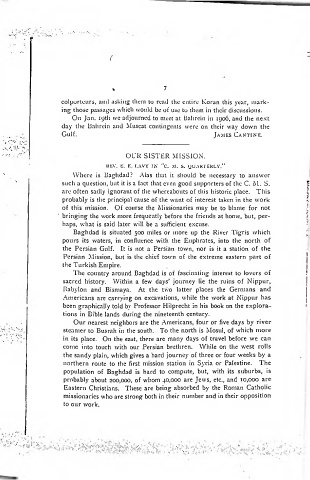Page 439 - Neglected Arabia (1902-1905)
P. 439
N*
• *
• ••
/'
7
colporteurs, and asking them to read the entire Koran this year, mark
ing those passages which would be of use to them in their discussions.
On Jan. 19th wc adjourned to meet at Bahrein in 1906, and the next
day the Bahrein and Muscat contingents were on their way down the
Gulf. James Cant ini:.
.* .* *
OUR SISTER MISSION.
HEW E. E. LAW IN “c. M. S. (JUAHTEHLV."
*.
Where is Baghdad? Alas that it should be necessary to answer
such a question, but it is a fact that even good supporters of the C. M. S. s
$
are often sadly ignorant of the whereabouts of this historic place. This
probably is the principal cause of the want of interest taken in the work
:*
of this mission. Of course the Missionaries may be to blame for not
bringing the work more frequently before the friends at home, but, per !
haps, what is said later will be a sufficient excuse.
Baghdad is situated 500 miles or more up the River Tigris which >
pours its waters, in continence with the Euphrates, into the north of
the Persian Gulf. It is not a Persian town, nor is it a station of the
1
Persian Mission, but is the chief town of the extreme eastern part of
the Turkish Empire.
The country around Baghdad is of fascinating interest to lovers of !
sacred history. Within a few days’ journey lie the ruins of Nippur,
Babylon and Bismaya. At the two latter places the Germans and
Americans are carrying on excavations, while the work at Nippur has
been graphically told by Professor Hilprecht in his book on the explora
tions in Bible lands during the nineteenth century.
Our nearest neighbors are the Americans, four or five days by river
v.
steamer to Busrah in the south. To the north is Mosul, of which more
in its place. On the east, there are many days of travel before we can
come into touch with our Persian brethren. While on the west rolls
the sandy plain, which gives a hard journey of three or four weeks by a
northern route to the first mission station in Syria or Palestine. The
population of Baghdad is hard to compute, but, with its suburbs, is
probably about 200,000. of whom 40,000 are Jews, etc., and 10,000 are
Eastern Christians. These are being absorbed by the Roman Catholic
missionaries who are strong both in their number and in their opposition
to our work.
#•.
i •• • .•

